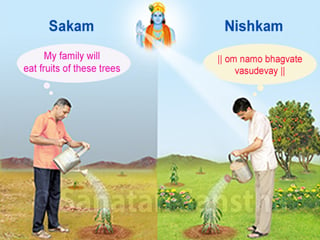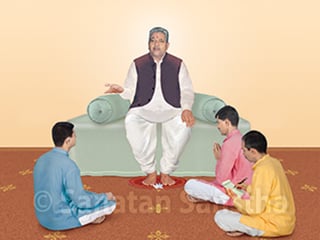Most people have theoretical knowledge on how to perform sadhana (Spiritual practice) and how to progress to the further stages in sadhana through discourses or reading. Yet, people do not make efforts to persevere with sadhana, because the analysis of the exact stages in the journey towards God-realisation are not mentioned anywhere. This article includes theoretical knowledge on stages in God-realisation and how it can be possible for one to establish communion with God.
In the journey towards God-realisation God explains Dharma (Righteousness) to an individual in the following order :
A. Kartrudharma (Dharma of the doer) : Kartrudharma means performing every action in life as per the laws in the Hindu Dharma. In the journey towards God-realisation, God first explains his Kartrudharma to the individual.
B. Karmadharma (Dharma underlying the karmas) : Karmadharma means performing actions with complete understanding of the spiritual science underlying them.
C. Sanskardharma (Dharma of creating sanskars [Subconscious impression]) : Sanskardharma means contemplation on the spiritual science underlying karma with continuous efforts for God-realisation, and taking these sanskars forward to the next generation.
1. Stages in God-realisation
A. When intense yearning for God-realisation develops in the individual spontaneously, sadhana commences in his subconscious mind.
B. On the strength of this sadhana, he can remain in communion with God even in sleep.
C. God helps him directly as well as indirectly in proportion to his yearning. Seeing the response of God to his yearning, his faith in God increases, so does his attraction for going towards God.
D. This attraction makes him forget himself, and his sadhana goes on continuously. Here, his dehabuddhi (Body-awareness) reduces, and he obtains the spiritual experience of Anand (Bliss) hidden within him.
E. Faith gradually gets transformed into devotion : While performing sadhana, he experiences a different type of happiness, of which he is unaware. He only knows that he likes to perform sadhana. That is why, his faith in God gradually gets transformed into devotion. His sadhana and yearning for God becomes so intense that from moment to moment he remembers only God and begins to forget himself, that is, his ego. In this way, due to yearning, his mind, intellect and ego undergo dissolution, and devotion for God develops within him. It is because of this very devotion that he can merge with God. The more intense the yearning for God-realisation in a seeker, the more efforts God Himself makes to eliminate the physical and subtle obstacles in his sadhana.
2. How can we maintain communion with God ?
Communion with God means remaining in contact with Him all the time. God is very subtle, and so are His mission and thoughts. The mind and intellect obstruct the process of establishing communion with God, because when compared with God, they are gross. To make the mind and intellect subtle, it is necessary to increase their Sattva component. If efforts are made to perform sadhana and eradicate personality defects and ego, the mind and intellect will become sattvik (Sattva-predominant). As their Sattva component increases, it becomes easier for the mind and intellect to grasp the subtlemost thoughts emanating from God. Even if one thought from God is imbibed, communion with God is established for that moment. Those who follow Bhaktiyoga (Path of Devotion) in sadhana establish communion with God by chanting His Name. Hence, they experience Anand while chanting. Since the mind and intellect of Saints are very sattvik, they are in continuous communion with God.
Reference : Sanatan’s Holy text ‘Sadhana (Spiritual practice) (General information and importance)’

 How the path of sadhana (Spiritual path) created by God has changed over various Yugs (Eras)
How the path of sadhana (Spiritual path) created by God has changed over various Yugs (Eras) Why Nishkam sadhana is superior to Sakam sadhana ?
Why Nishkam sadhana is superior to Sakam sadhana ? Importance of performing sadhana under the guidance of a guru
Importance of performing sadhana under the guidance of a guru What is sadhana (Spiritual practice) ?
What is sadhana (Spiritual practice) ?